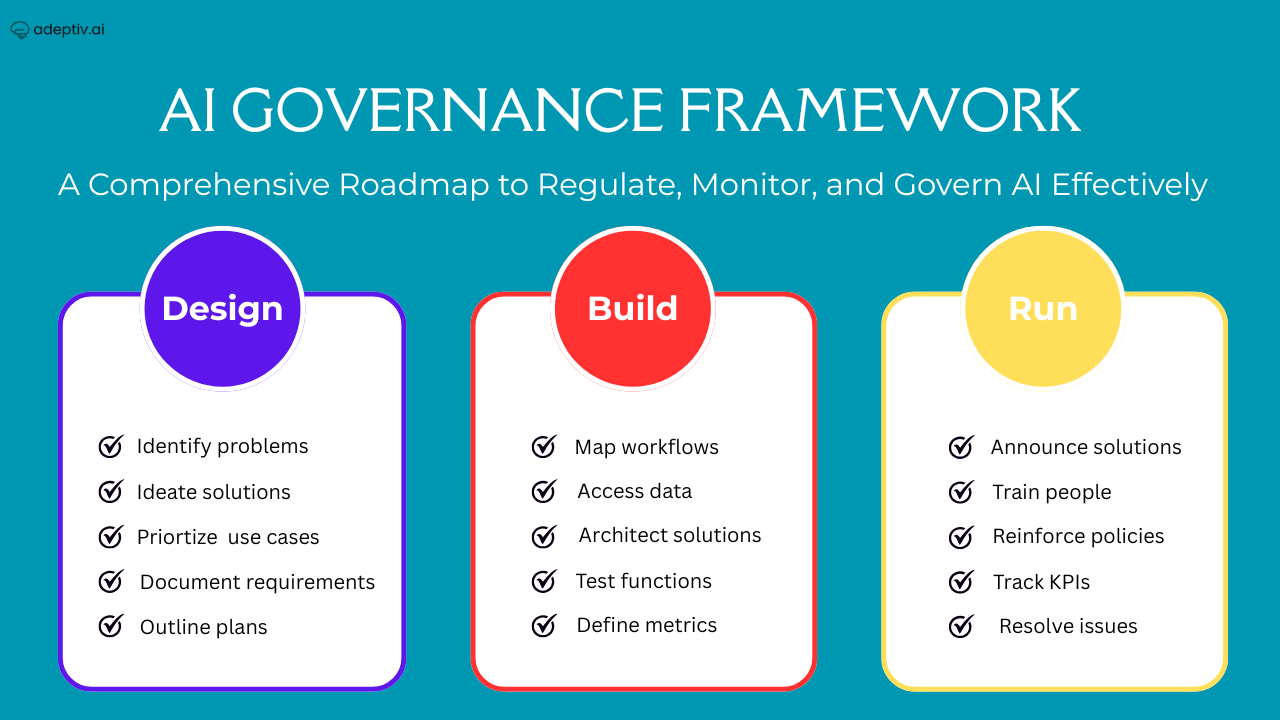At A Glance & Strategic Imperatives for Leaders:
The blog focuses on following points:
AI governance is not a luxury; it’s a competitive advantage. Organizations that embed governance early:
- Achieve measurable ROI.
- Minimize operational and reputational risks.
- Foster stakeholder trust.
- Accelerate innovation safely.
A solid governance strategy includes principles, structure, tools, and culture. Combine frameworks like NIST, modern data governance, and ethical models to create responsible, auditable AI systems.
AI is no longer experimental; it’s essential to business operations. But without proper governance, AI systems can cause unintended harm, including bias, privacy breaches, regulatory fines, and damage to reputation. According to ISACA, AI governance helps organizations speed up responsible, transparent, and explainable AI workflows. This enables them to monitor and manage AI across the enterprise while reducing
The Business Case for AI Governance
AI governance isn’t just about ethics; it also drives financial performance. Gartner data shared by Alation shows that organizations with mature data and AI governance can see a 21 to 49 percent improvement in financial performance, with potential gains reaching 54 percent for those improving data culture maturity.
Financial Impact
Failure to implement governance is costly. For example, Citigroup paid a $136 million fine due to unresolved data issues, and T-Mobile paid $60 million for unauthorized data access.
Strategic Alignment & Risk Reduction
Adopting governance frameworks like NIST creates structured alignment between AI initiatives and business goals. It establishes clear ownership and robust risk mitigation throughout the AI lifecycle, helping enterprises protect their assets and outcomes.
Key Components of a Robust AI Governance Framework
Core Principles – The Foundation
According to Nutanix and ISACA, any strong AI governance strategy must include the following five core principles. These aren’t just checkboxes; they are the foundation for building trustworthy, scalable, and compliant AI systems.
Transparency: Explainable and Traceable AI Decisions
Transparency means making AI systems understandable for every stakeholder, including developers, auditors, end-users, and regulators.
– Explainability: Use methods like SHAP, LIME, or integrated gradients to show how inputs influence outputs.
– Decision Logs: Keep model decision logs to ensure every outcome can be audited later if challenged.
– User-Facing Clarity: Clearly inform users when AI is in use (e.g., “AI-generated recommendation” or “Risk score calculated by machine learning”).
Example: The EU AI Act mandates transparency obligations for high-risk AI, requiring organizations to disclose when users interact with AI systems.
Fairness: Mitigating Bias and Ensuring Equity
Fairness ensures AI treats all users and data subjects fairly.
– Bias Audits: Regularly test datasets for underrepresentation or bias. For instance, check if certain demographic groups are over- or under-represented in training data.
– Fairness Metrics: Track metrics like demographic parity, equalized odds, or disparate impact to measure whether outcomes are fair.
– Inclusive Design: Involve diverse stakeholders early to identify blind spots during model development.
Example: Microsoft uses fairness dashboards in Azure ML to visualize bias and monitor model behavior across groups.
Accountability: Clear Ownership and Escalation Paths
Accountability ensures that AI systems have “human owners” responsible for their outcomes.
– Governance Board: Create an AI governance committee with representatives from product, legal, compliance, and security.
– RACI Matrices: Assign clear roles (Responsible, Accountable, Consulted, Informed) for AI projects, making decision-making traceable.
– Ethics Escalation: Establish formal pathways for employees to report harmful or biased AI behavior.
Example: Google’s AI Principles include an internal review process where sensitive AI projects undergo ethics committees before deployment.
Privacy & Security: Safeguarding Data and Models
Data is the fuel of AI; protecting it is essential.
– Privacy by Design: Collect only the minimum data needed. Use anonymization, encryption, and pseudonymization techniques whenever possible.
– Compliance Alignment: Meet global privacy regulations like GDPR, CCPA, and emerging AI-specific laws (EU AI Act, Colorado AI Act).
– Security Testing: Regularly test models for vulnerabilities such as data leakage, model inversion, and adversarial attacks through red-teaming exercises.
Example: Apple’s on-device machine learning for iOS prioritizes privacy by keeping most AI processing local, which reduces the exposure of sensitive data.
Documentation: Institutional Memory for AI
Documenting decisions ensures traceability, auditability, and regulatory readiness.
– Model Cards: Provide a “nutrition label” for each model, detailing intended use, limitations, and demographic performance.
– Data Sheets for Datasets: Document where data came from, who collected it, and how it can and cannot be used.
– Version Control: Track dataset versions, model updates, and governance decisions to maintain a single source of truth.
Example: IBM Watson uses detailed model cards and audit logs for enterprise customers to meet compliance requirements in regulated industries.
Procedural Best Practices
The Hourglass Model of Organizational AI Governance frames governance across environmental, organizational, and system levels. This approach ensures ethical alignment and compliance throughout the AI lifecycle.
Similarly, IBM defines AI governance as a set of processes, standards, and guidelines to ensure safety, fairness, and alignment with societal norms.
Governance in Data – The Critical Lever
AI relies on trusted, high-quality data, which requires robust data governance. Modern approaches emphasize proactive governance through automation and metadata management. These practices ensure data is discoverable, auditable, and trustworthy.
Tools & Platforms in Action
Platforms like Alation provide a centralized hub for AI documentation, lineage tracking, and data cataloging. Enterprises like Interac rely on this approach to maintain transparency, auditability, and AI governance at scale.
Implementation Challenges & Mitigation
Cultural and Structural Barriers
In organizations like AstraZeneca, implementing AI governance has faced challenges due to decentralized structures, inconsistent standards, and the difficulty of turning ethics into practical action. Success requires clear language, a risk-focused approach, and ongoing education.
Continuous Auditing & Compliance Certification
ISACA’s AI Audit Toolkit helps organizations verify that their AI systems meet ethical and legal standards, building assurance and regulatory confidence.
Scaling Governance without Slowing Innovation
The challenge is to enable rapid AI innovation while maintaining guardrails. Nutanix emphasizes the need for upfront governance planning using cloud and AI governance frameworks to align outcomes, support speed, and reduce risk.
AI Governance in Action – Real-World Examples
– GXS Bank (Singapore): Uses governed AI with alternative data to serve underserved populations. Trustworthy data drives impact.
– Alation Users (e.g., Interac): Achieve transparency and scalable AI governance through lineage tracking, model card documentation, and data quality monitoring.
– AU & UK AI Safety Institutes (2023 AI Safety Summit): Government-led initiatives highlight the critical need for trustworthy AI standards.
How Adeptiv AI Empowers Governed AI – From Theory to Action
Adeptiv AI helps enterprises to:
– Automatically document AI lifecycles (model cards, lineage, risk registers)
– Implement role-based governance aligned with frameworks like EU AI Act, ISO, and NIST AI RMF
– Collaborate across departments with clear oversight
– Achieve governance ROI through automation and faster time-to-marketess in the most optimize way which can reduce their compliance cost. By contact us business can get first hand experience with our diverse team. To know more about our platform, you can contact us through our website.
1. What’s the ROI of AI governance?
Governance maturity can boost financial performance by 21 to 49 percent, with optimal outcomes reaching about 54 percent.
2. Which frameworks should I follow?
COBIT, ISO/IEC 42001, and NIST AI RMF are good starting points. They establish governance structures, accountability, and risk management.
3. How do we resolve organizational resistance?
Use practical frameworks like the Hourglass model and invest in change management to incorporate governance without hindering innovation.
4. Can governance scale in agile environments?
Yes, using modern data governance techniques like automated metadata and catalogs, along with tools like Alation, allows real-time governance at scale.
5. What is Adeptiv AI’s edge?
Adeptiv AI provides integrated governance by combining automation, documentation, accessible workflows, and compliance across frameworks—enabling faster, safer AI adoption.



